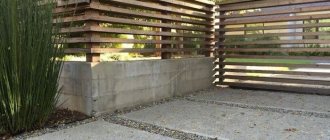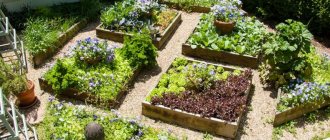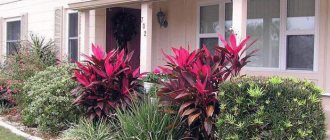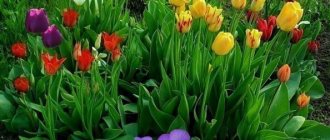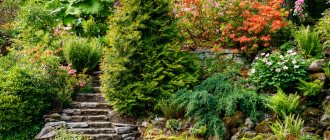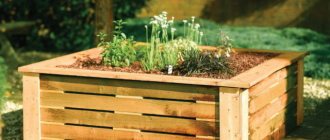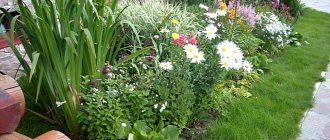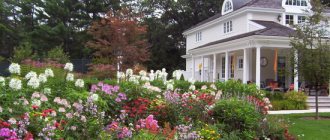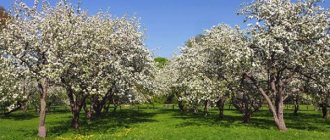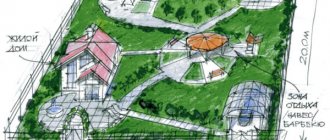The front side of the personal plot is the business card of the owners. Even if there is only a meter of free land between the fence and the road, this usable area can be transformed beyond recognition.
Some summer residents fence their land holdings with a chain-link fence or wooden picket fence, others prefer to hide from prying eyes behind a blank fence made of corrugated sheets or enclose the area with a brick wall.
The type of fence is a matter of taste and financial capabilities of everyone. But in front of any fence there is usually a piece of land left, which you also don’t want to let go. What plants should be planted here to transform the entrance to the site and brighten up the dull appearance of the fence?
Landscape Design Rules
The main area of the dacha is occupied by healthy fruit and berry plantings, vegetables and herbs. Naturally, there is very little space left for a flower garden.
As a rule, these are spaces along fences and near a country house. To fill this void, you need to know the principles of flower bed design.
Before deciding what to plant, you need to answer the following questions:
how much area is planned to be devoted to a flower garden. If the flower bed near the fence is long and large, then the choice of plants is practically unlimited. If there is very little space in the dacha, then the flowers should be miniature and not “aggressive”.
When planting, it is important to plant plants with the same requirements for watering, soil, and light. To do this, you need to find out which side the fence is on (sunny or shady), what crops the dacha owner plans to plant (whether they require care or not).
Flower garden along the fence Source pinterest.com
Near what kind of fence will there be a flower garden: solid or sparse (made of wooden slats, chain-link mesh, metal profile). What is the height of the fence, how hot does it get, whether it is necessary to hide the fence with plantings or leave it open.
When planting plants on the south side of the site, choose drought-resistant crops that need a lot of light. The soil in this part of the dacha will need to be constantly watered, so it is not recommended to plant delicate plants here that require abundant watering: crocuses, tulips. For a flower bed along the southern part of the fence, planting thyme, iris, and mallow is perfect.
On the northern side of the site, plants that can withstand strong winds and are cold-resistant are planted. For a flower bed near a fence, hosta plantings, stone compositions with coniferous shrubs, horizontal juniper, and ferns are well suited. In addition to low-growing plants, tall thujas can be planted on the side of the fence.
Most often, a flower bed is made with smooth borders and curves, as in this photo Source samozvetik.ru
Rigid rectangular flower beds can be arranged in the form of small compositions of flowers of different colors, but of the same type. For example, marigolds, petunias.
Flower arrangement Source pinterest.com.mx
Zoning
Dividing the garden into sectors is a fundamental point. The fertility of the crops grown depends on the successful choice of location for the beds. Accordingly, economic efficiency increases, because vegetables and fruits from the dacha are stocked for almost the whole year. And it’s just nice when efforts in the garden bring good results.
The three pillars on which fruitful gardening is built are the terrain, the composition of the soil and its moisture.
Relief of the site
Not all elevation changes; the slopes are suitable for vegetable growing, growing fruit crops and growing flowers. You should not plant a garden or vegetable garden in lowlands or hollows, especially narrow and extended ones. The temperature in them is always lower due to stagnation of cold air, and the soil is too wet. In such an area, plants will die from frost or rot.
Every 100 meters upward results in a decrease in the average annual temperature by half a degree or a degree. This seems like an insignificant difference, but for some plants it can be disastrous during the first frost.
For most plantings, the best option is a not very flat, but not entirely level area with an orientation to the southwest and southeast. The lower part of such an area will be wetter, shady and cooler. It is more suitable for shade-loving plants that require a lot of moisture.
As you rise, the land will become drier and the temperature higher. The very top will warm up in the sun faster and more efficiently. In increasing order, it is convenient to plant vegetable and berry crops in accordance with their needs for sun and water.
Climate of the region
In the north-west of the country, the most suitable slope for an orchard is considered to be one with a southern side, sloping more towards the west than towards the east. On the Ural and Siberian slopes, on the contrary, you need to choose the eastern side for protection from the harsh climate. Southern, mountainous regions in any area have the same problem - lack of moisture. A flat area or a gentle slope with an irrigation system is optimal.
Soil and subsoil composition
Choosing a suitable environment for the development of the plant root system is a job for a specialist.
Fortunately for gardeners, soil type is not a death sentence. Fertilizing, plowing or forming a new layer of black soil today are available services that are often used by owners of private gardens.
Good soil is permeable to water and air - it has a loose structure. Suitable for growing crops: slightly podzolic, loamy, sandy loam, gray soil compositions. Gardens are also easily created in the forest-steppe, with brown, chestnut and black composition.
Soil moisture level
It is directly influenced by the presence of groundwater. They usually feed plants, but if they are too close to the root system, they cool the soil, saturate it with sulfates and create unfavorable conditions for growth. The distance of groundwater from the root system should be at least 2 meters.
The distance from the surface of the earth is considered depending on the species, plant variety and rootstock. For example, for apple trees on a dwarf rootstock - 1-1.2 m, and for another rootstock, at least one and a half meters is required.
If you already have a country house and green spaces, for redesigning the garden you need to choose places based on the relationships between objects and plants. For example, for light-loving plants, it is important to plant a front garden in front of the house. And behind the home, in the shade of the walls, shade-loving crops will feel good.
You can also plant low shrubs in front of the house, focusing their height on the window frames. Bushes and trees can be placed around the perimeter, vegetable crops - in the center of the site. Vegetables such as pumpkin, zucchini, and cabbage like to change their place of “residence” in the beds from time to time.
Planting along a mesh fence
To decorate a chain-link fence, many people use ordinary climbing plants: hops, virgin grapes, Jerusalem artichoke.
Flower garden Source news.rambler.ru
Some owners plant beans or peas.
In addition to them, a flower garden is planted, consisting of shade-tolerant plants and undemanding plants: lupine, rudbeckia (golden ball).
A flowerbed next to a mesh fence can consist of perennials Source sewerge.ru
Perennial plants for places near fences
Let us remember that plants that live for more than two years are called perennial. Much depends on the climate and the area of the country where the fence is located. Crimea and Sochi are one thing, the middle zone and further north are another.
Typically, shrubs that do not need regular crown pruning are used for these purposes.
Mostly wild grapes, hops and ivy are planted. The latter retains its color even in winter, prefers moist soils and does well in partial shade. Climbing roses are very beautiful. However, they are quite capricious in care, cannot tolerate drafts, require fertile soils, timely watering and care.
To reduce the number of curious glances at your estate, you need to build a green wall.
Many people are interested in what to plant perennials along the fence in the country on the shady side of the garden. Hosta, lily of the valley, meadowsweet and ferns are suitable.
They are unpretentious in maintenance and are able to close off the territory of a private house from prying eyes.
Planting along a wooden picket fence
A rare picket fence can be decorated on the wall side with tall flowers, for example, hydrangea, mallow or sunflower, and of course vines. These are girlish grapes, clematis, actinidia. And along the perimeter there are medium-sized or low-growing shade-loving crops.
In addition to flowers, it is popular among gardeners to plant small shrubs along wooden fences, such as honeysuckle, raspberries, currants, lilacs and others.
As for flowers, marigolds, petunia, and lobelia are used as low-growing flowers along the fence. First, a raised platform is used to organize the flower bed. Landscape design of a flower garden does not exclude hand-made. This can be any available materials: tires, tree logs, beautifully dug along the perimeter of the curb.
Small carts or even vintage bicycles that are used as flower beds Source urlaubitaliano.de
Corrugated sheeting, brick or natural stone
Even an openwork fence built of brick, and even more so a crudely deliberate stone structure, suggests the use of only plants under them that are accustomed to the shade. On a narrow strip under such a fence, there usually remains only an unpretentious path of lawn grass or stunted saxifrage bushes.
Flower beds along the fence on the site
Meanwhile, by creating a coniferous strip with trees of different heights, you can not only close the fence on the side of the house, but also use the ribbon flower garden technique with long wild plants, which are usually unpretentious and do not require long-term care.
Unlike mixborders, where different plants are used for constant flowering, this is not necessary in narrow ribbons. The main thing is that the strip of conifers, monotonous in color, should contain bright spots, giving it natural splendor and naturalness.
An excellent example of the combination of conifers with bright inflorescences of flower beds along the fence
If we create this option, we can leave a gap between the spruce trees or thujas a little more than usual. To enhance the bright effect, creating a flower bed below and the overall impression is created by hanging pots with hanging plants on the fence.
Do-it-yourself diagram of a flower garden in front of a fence
You can also plant lush, low-growing flowers, placed in hanging beds made from scrap materials.
Sketch of landscaping along the fence
Planting along a metal fence
The profile fence gets very hot in summer, so the plants are placed at a distance from it to avoid burns. For a flower garden along such a continuous fence, you can use plants of the same type. Hostas, decorative alliums, hydrangeas, etc.
Any beautiful tall flowers, as well as delphinium, pansies, and gladioli, are suitable for a lattice metal fence Source pinterest.com
Color combinations are used in such a way that flowering continues throughout the season. Thanks to this, flower beds along the fence will always look elegant and beautiful.
Flowers for large and wide flower beds along the fence are planted in tiered order. The closer to the fence, the higher the plant; the further away, the lower.
Stones, bricks, and bottles are used for decorative borders.
In the foreground are boxwood, low-growing thujas and junipers. Then, perennials are planted along the perimeter of the fence: primroses, heucheras, saxifrage.
If desired, the flower garden is supplemented with annuals: nasturtium, marigolds, snapdragons Source dachnyedela.ru
What to consider when disembarking
Before you go shopping for seedlings, think about the following points:
- is your side shady or sunny?
- how much wind blows the area;
- what is the purpose of planting: protection, decoration or shade formation;
- estimated area of landscaping;
- specifics of the dacha layout;
- what is the design of the fence (color, material);
- required planting height;
- depth of groundwater;
- soil type and composition, climatic features of the area;
- type of seedlings (requiring care or unpretentious);
- compatibility of different cultures;
- how long will the selected seedling grow to the desired size.
If the size allows, then planting is carried out in several ranks. Thus, a solid green wall is formed.
https://www.youtube.com/watch?v=36N2T9sKUUc
Low plants (for example, blue spruce) are recommended to be located closer to the road so that they absorb harmful exhaust gases from car fuel.
We must not forget about the rapidly developing root system, which can damage the base of the fence, so the distance from the seedlings to the fence should be from 3 to 5 m. With a smaller value, the roots, as they grow, will lead to cracks in the foundation or a nearby fence will shade the trees.
If you decide to plant plants near your home for the first time, we advise you to consider the following:
- The best time to plant or replant plants is autumn. But it is advisable to complete the work before mid-October, so that the seedling has time to take root before the first cold weather.
- If flowering occurs in the spring, then you need to plant it in the fall; if it blooms at the end of summer, you can start planting in the spring.
- Planting any type of living plants at sub-zero temperatures is impossible.
- If the work was not completed before the end of October, you can try to protect the roots of the seedlings with mulching (peat, sawdust, leaves).
- All flowering and fruiting plants are planted on the sunny side of the site.
- The distance from the road surface should be from 30 to 50 cm.
We invite you to familiarize yourself with the benefits of blueberry jam. What are the benefits of blueberry jam?
Shrubs and trees along the fence
Very often, summer residents place trees and shrubs along the fence.
Trees and shrubs along the fence Source gardencreator.net
The most unpretentious of trees: mountain ash, hawthorn, fir, pine Source samstroy.com
When planting tall seedlings, their growth should be taken into account, so they are planted at a distance of 3-5 meters from the house, otherwise they can damage the foundation of the building.
More often, dogwood, elderberry, hydrangea, and dogwood bushes are located next to the fence. When planting the latter, take into account that it does not get along with barberry.
On the outside of the fence, it is customary to plant decorative species of shrubs that can create a hedge.
These can be rose hips, viburnum, bird cherry bushes Source wallpaperup.com
Where to start transforming your summer cottage?
Don't start work without a well-thought-out plan
This can be a sketch or diagram, it is important to decide on the main objects
A diagram of a garden plot can be drawn on a sheet of paper.
It is better to divide the entire site into zones, which should be separated by barriers, but well-designed passages and paths should lead to them.
1. Outdoor cooking area. On a site in the yard or garden. This is a barbecue grill, a barbecue, a Russian oven or a paved fire pit with a spit. Away from trees and dead wood, there should be no sparks from the fire. 2. A place for lunch and dinner in the open air. Equipped with garden furniture. This is a gazebo, a covered terrace or an open veranda, an area under a canopy or canopy made of polycarbonate or slate. 3. Water supply, sewerage, drainage, well
They provide circulation and supply of water to the food preparation point, outdoor washbasin, swimming pool, a well-organized irrigation system for the entire area, it is important to consider drainage. 4. Artificial reservoirs. The choice depends on the size of the plot, access to the water supply (well) and the needs of the owners - an inflatable (children's), mobile or stationary pool, fountain pond, waterfall, cascade, etc. It is better to contact specialists; they can do the simplest work themselves
5. Bathhouse, summer shower. The scale of construction depends on seasonality; it is better to build a permanent structure with waterproofing, firebox, drainage and insulation (all-season use). 6. Toilet. It is better to have 2 points - an indoor toilet in the house and an outdoor (street) toilet. It is convenient to equip with a septic tank so that waste does not get into groundwater; the smell is removed with special neutralizers poured into the hole. 7. Summer vacation spots. Swings, benches, gazebos, canopies with upholstered or garden furniture. It is better to do it in the depths of the garden, along paths, under flower arches, opposite green spaces and flower beds, on the lawn. 8. Garden and vegetable garden Many people abandon traditional cultivation in favor of decorative beds and a cultivated garden with landscape design. 9. Green spaces Decorative flower arrangements of various types, hedges, flower beds, gazebos, arches. 10. Garden alleys, paths, paths. A necessary element to unite all objects, their lack is felt after the rain. 11. Children's playground. A sandbox under a canopy is the basis, additions are towers and tents, cars and rockets, sports obstacle courses, stumps and fences with decor.
The playground should be located on level ground and clearly visible
Having distributed the main objects, they plan landscaping, and not vice versa. It is difficult to replant trees and shrubs; large costs will be spent on moving finished buildings. But it makes sense to remove a barn or cellar that is obsolete in order to move it into an extension to the house
It is important to think about where the seedlings will be grown and where to put the greenhouse, if one is needed at all.
A site with a slope must be strengthened with terraces, equipped with steps, bars and cascading galleries made of brick and stone. The masonry can be left “wild” or decorated with cladding. Wood scraps can also be used, but they will not last long.
A stone retaining wall will last for many decades
When organizing leisure facilities, all the wishes of family members are taken into account. The children's playground is located in a place in the garden that is clearly visible from the yard and windows of the dacha. And decorating the garden plot with flowers, figurines and decor is secondary.
- When designing landscape compositions, natural forms are a priority, natural relief, curved shapes are played out, you can make a small pond.
- The wild or Moorish style looks like an abandoned garden or part of the wild, where the porch leads. The design is appropriate if the site faces a lake or river. Then the most “cultivated” one is the courtyard with a lawn and flower mixborders.
The garden begins at the gate
Mixborders: photo ideas
Recently, landscape design along the fence has been organized using mixborders. These are plantings that are very diverse and bloom at different times. Thanks to these properties, mixborders look beautiful at any time of the year.
Flower arrangements can include not only low-growing plants, but also shrubs, fruit trees, climbing vines and other garden inhabitants.
When organizing this type of flower bed, the owner of the dacha must choose the plants correctly.
A landscape designer who knows the characteristics of each plant and its compatibility with its neighbors will help you cope with this. Source pinterest.com
The benefits of a variety of crafts for the garden
It is impossible to imagine a private home without handmade products. They serve as the calling card of any owner, his desire to improve the area, making it more suitable for comfort on vacation.
Crafts for the garden have a number of advantages. For example:
- It's a great time with family. By involving children, you can instill in them hard work in such a simple and interesting form for them, and also draw imagination from restless kids yourself, which will help diversify the creative process and bring something new to products.
- In addition, you can use those available means that will not hurt your pocket. Craft material:
- tree;
- laser discs;
- car tires;
- Styrofoam;
- concrete;
- plastic bottles;
- stone and many more etc.
- A craft made with your own hands will give you confidence in your abilities and a special joy from relaxation, and at the same time the dacha will look much more attractive.
Well, the most important thing is that you can make it quickly and without much effort. You will even need a tool that is in every home
It’s very easy to choose a craft that’s suitable for your project; the photos of the products located on this site will help you with this.
Popular articles The most fragrant and fragrant varieties of roses
Types of flower beds
There are several types of mixborders depending on its design and content:
Classic flower garden along the fence (English type). Characterized by its strict lines, tree crowns are typically shaped and trimmed to form a crown. In the vicinity of such shrubs there are cereal crops (rye, oats, etc.), aster and other ornamental flowers.
Classic flower garden Source m.yukle.mobi
Meadow type of flower bed. It assumes a chaotic arrangement of meadow flowers, as they grow in nature: daisies, cornflowers, wild cereals and others.
Meadow type of flower bed Source pxhere.com
Village type. In the vicinity of lush flowering cereal crops and herbs, you can find decorative flowers and even berry bushes.
Rustic type of flower bed Source decoratorist.com
Mixborder scheme
Plant tall plants up to 1.5 meters in height closest to the fence. These are rudbeckia, asteraceae, foxgloves and other perennials with large flowers and leaves.
When selecting flower arrangements, designers usually arrange two or three crops of different flowering periods together so that the fence does not look bare.
Secondly, medium-sized plants are planted. This row creates the splendor of the entire composition, so plants are chosen for it that, even after flowering, do not lose their attractiveness.
These can be pinesettum, chrysanthemums, lavender Source sewerge.ru
Lastly, form the border of the flower bed. Ground cover plants are best suited for this. For example, spirea, nasturtium, cornflowers.
An example of a mixborder scheme Source krapivada.ru
Photo examples of beautiful solutions
The current option is to plant flowers and shrubs along the fence Source pinterest.com
There is no need to plant plants that will grow quickly Source wearefound.com
All plants must have similar watering needs Source gardenscout.com
Easy-to-care plants can decorate any area Source artsoznanie.com
Various plants that bloom at the same time create a magnificent riot of colors Source pinterest.com
It is better to choose unpretentious plants Source stroypay.ru
For this option you need to choose low-growing plants Source nightcore.club
It is better to choose plants that are easy to care for. Source pinterest.ca
Many plants can bloom until October (in warm weather) Source pinterest.com
Successful combination of colors Source landshaft-stroy.ru
Many plants can hide even a nondescript fence Source landshaft-stroy.ru
When choosing plants, you need to take into account the illumination of the area Source pinterest.com
All flowers should have similar soil needs Source pinterest.com
Some plants can grow too quickly Source pxhere.com
Annual flowers
You can plant the area along the fence with annual flowers. With this approach, you will have the opportunity to change the “scenery” every year. For example, in the coming season you can organize a long yellow-orange flowerbed here, and next year “paint” it in red tones.
- 17 annuals with yellow and orange flowers - let the sun into the garden!
Yellow and orange annuals will add light and sunny notes to your flower garden. Be sure to plant them in your garden!
- 15 annuals with red flowers - bright colors in your garden
Do you want to add bright accents to your flower garden? Red annuals will help you do this without any extra work.
When choosing flower crops, take into account the characteristics of each: in what period does it bloom, does it like the sun or is it ready to withstand shade, how resistant to drought is it? If you choose the right company of annuals, you can achieve a continuous riot of colors from spring to late autumn - the neighbors will not remain indifferent.
Give preference to non-capricious plants: marigolds, nemophila, alyssum, cornflowers, gypsophila, clarkia, limnanthes, calendula, eschscholzia, catharanthus, petunia, lobelia, dimorphotheca, cosmos, zinnia, iberis, etc.
Decorative leafy annuals will look great on the outside of the fence: coleus, perilla, irezine, ornamental cabbage, silver cineraria, castor bean, kochia, etc. You can create a spectacular ensemble only from decorative leafy crops or plant them in company with flowering plants.
